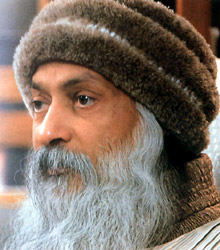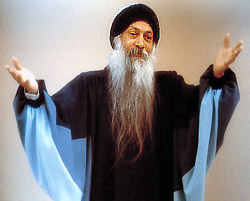"One has to reach to the absolute state of awareness: that is Zen. You cannot do it every morning for a few minutes or for half an hour and then forget all about it. It has to become like your heartbeat. You have to sit in it, you have to walk in it. Yes, you have even to sleep in it." -Osho. To Osho the greatest values in life are awareness, love, meditation, celebration, creativity and laughter. He said that enlightenment is everyone`s natural state. But by the human activity of thought one is distracted from realising it. He was a fecund speaker on various spiritual traditions, includes those of Budhha, Krishna, Guru Nanak, Jesus, Socrates, Zen masters, Gurdjieff, Sufism, Hassisism, Tantra and many others. Since he believed that no philosophy can fully express the truth, attempted to ensure that no `system of thought` would define him. He loved to disturb people because to him only by doing this he make them to think.
 ]Osho was born on 11th December 1931 in a small village namely Narsinghpur District of Madhya Pradesh state in India as the eldest of eleven children to a cloth merchant. His parents sent him to live with his maternal grandparents until he was seven years old. That played a major influence on his growth. His grandfather used to tell him, "I know you are doing the right thing. Everyone may tell you that you are wrong. But nobody knows which situation you are in. Only you can decide in your situation. Do whatsoever you feel is right. I will support you. I love you and respect you as well." He received a B.A in 1955 and M.A in Philosophy in 1957 from D.N.Jain College and the University of Sagar. After that he taught philosophy, first at Raipur Sanskrit College and then at Jabalpur University as a Professor until 1966. At the same time, he travelled throughout India, giving lectures critical of socialism and Gandhi, with the name Acharya Rajneesh. Prior to his death, Osho had expressed his belief that his rapid health decline was caused by some form of poison administered to him by the U.S. authorities during the twelve days he was held without bail in various U.S. prisons. On January 19, 1990, four years after his arrest, Osho died, aged 58, with heart failure being the publicly reported cause. In his newly built bedroom in one of the main buildings at his last place of residence, his Ashram in Pune, India His ashes were placed.
]Osho was born on 11th December 1931 in a small village namely Narsinghpur District of Madhya Pradesh state in India as the eldest of eleven children to a cloth merchant. His parents sent him to live with his maternal grandparents until he was seven years old. That played a major influence on his growth. His grandfather used to tell him, "I know you are doing the right thing. Everyone may tell you that you are wrong. But nobody knows which situation you are in. Only you can decide in your situation. Do whatsoever you feel is right. I will support you. I love you and respect you as well." He received a B.A in 1955 and M.A in Philosophy in 1957 from D.N.Jain College and the University of Sagar. After that he taught philosophy, first at Raipur Sanskrit College and then at Jabalpur University as a Professor until 1966. At the same time, he travelled throughout India, giving lectures critical of socialism and Gandhi, with the name Acharya Rajneesh. Prior to his death, Osho had expressed his belief that his rapid health decline was caused by some form of poison administered to him by the U.S. authorities during the twelve days he was held without bail in various U.S. prisons. On January 19, 1990, four years after his arrest, Osho died, aged 58, with heart failure being the publicly reported cause. In his newly built bedroom in one of the main buildings at his last place of residence, his Ashram in Pune, India His ashes were placed.
He started his public speaking at the annual Sarva Dharma Sammelan held at Jabalpur since 1939, organised by the Taranpanthi Jain community into which he was born. He participated there from 1951 to 1968. Eventually the Jain community stopped inviting him because of his radical ideas.
In 1968, he scandalised Hindu leaders by calling for freer acceptance of sex. In 1969 at the Second World Hindu Conference, he maddened the Hindus by criticising all organised religion and the very institution of priesthood. In 1969 a foundation to support his work in Mumbai was established by a group of Osho`s friends. The number and frequency of visitors soon became too much. On September 26, 1970 he initiated his first disciple or sannyasin at an outdoor meditation camp, one of the large gatherings where he lectured and guided group meditations. His concept of neo-sannyas entailed wearing the traditional orange dress of ascetic Hindu holy men. Osho`s neo-sannyasins only aim to renounce their identification with their past. According to Osho, neo-sannyas represents a readiness to take a jump into the future, into the unknown However, his sannyasins were not expected to follow an ascetic lifestyle.
According to Osho, meditation is merely relaxation, let-go not concentration. It is a state of watchfulness that has no ego fulfilment in it, something that happens when one is in a state of not-doing. There is no "how" to this, because "how" means doing - one has to understand that no doing is going to help. In that very understanding, non-doing happens. Osho often said that meditation is a science and does not need any belief. He has stated that for modern man it is difficult to just sit and be in meditation. With his `active meditation` techniques which involoves a beginning stage of activity, sometimes intensely physical follwed by a period of silence prepares the ground. His most significant meditation techniques are today known as "OSHO Dynamic Meditation", "OSHO Kundalini Meditation", "OSHO Nadabrahma Meditation" and "OSHO Nataraj Meditation". For each meditation, special music was composed to guide the meditator through the different phases of the meditations. Osho said that Dynamic Meditation was absolutely necessary for modern man. In the late eighties he developed a new group of "meditative therapies", known as OSHO Meditative Therapies - "OSHO Mystic Rose", "OSHO Born Again" and "OSHO No-Mind."
From 1971 Acharya Rajneesh was known as Bhagwan Shree Rajneesh. in 1974, on the 21st anniversary of his enlightenment, he and his group moved from the Mumbai apartment to a newly purchased property in Koregaon Park, in the city of Pune. By a Hindu fundamentalist an attempt on his life was made during one of his discourses in 1980. Osho taught at the Pune Ashram from 1974 to 1981.
On 1 May 1981, Osho entered a three-and-a-half-year period of self-imposed public silence, and satsangs which is silent sitting, with some readings from his works and music took the place of his discourses. He was suffering from asthma, diabetes and severe back problems. For a better medical treatment in mid-1981, Osho went to the United States. After a brief spell in Montclair, New Jersey, his followers bought (for US$6 million) a 64,000-acre ranch in Wasco County, Oregon, previously known as "The Big Muddy", where they settled for the next four years and legally incorporated a city named `Rajneeshpuram`. Over the coming years, he acquired fame for the large number of Rolls-Royces, the car his followers bought for his use. In October 1984 Osho ended his period of silence. In July 1985, he continue his daily public discourses in the commune`s purpose-built, two-acre meditation hall. According to statements he made to the press, he did so against the wishes of Ma Anand Sheela, his secretary and the commune`s top manager. The position of the Oregon commune became questionable because of increasing conflicts with neighbours and the state of Oregon, as well as serious and criminal misconduct by the commune`s management including conspiracy to murder public officials, wiretapping within the commune, the attempted murder of Osho`s personal physician, and a bioterrorism attack on the citizens of The Dalles, Oregon, using salmonella. In late October 1985, Osho himself was arrested in North Carolina. He was accused of minor immigration violations and was given a suspended sentence on condition that he leave the country.
 Osho then began a world tour, being refused entry visas by more than twenty different countries spoke in Nepal, Greece and Uruguay, among others. He returned to India in July 1986, and in January 1987, to his old Ashram in Pune, India. In late December 1988, he said he no longer wished to be called as Bhagwan Shree Rajneesh, and shortly afterwards took the name Osho.
Osho then began a world tour, being refused entry visas by more than twenty different countries spoke in Nepal, Greece and Uruguay, among others. He returned to India in July 1986, and in January 1987, to his old Ashram in Pune, India. In late December 1988, he said he no longer wished to be called as Bhagwan Shree Rajneesh, and shortly afterwards took the name Osho.
After some speeches in the late 1960s on sexuality he was often called the "sex guru". These were later put together under the title "From Sex to Superconsciousness". To him, "For Tantra everything is holy, nothing is unholy", and all repressive sexual morality was self-defeating, since one could not transcend sex without experiencing it thoroughly and consciously. In 1985, he told the Bombay `Illustrated Weekly`- "I have never been a celibate. If people believe so, that is their foolishness. I have always loved women - and perhaps more women than anybody else. You can see my beard: it has become gray so quickly because I have lived so intensely that I have compressed almost two hundred years into fifty".
A strong inclination for courting controversy was very much associated with Osho. Liberal views on sex and emotional expression resulted in unrestaining behaviour of the sannyasis in his Ashram in Pune. It also created panic among the people who were holding different views on these matters both in India and US. Osho said that he was "the rich man`s guru" and material poverty was not a spiritual value. Osho consistently attacked organisational principles embraced by societies around the world - the family, nationhood, religion, in his discourses. Osho dictated three books while undergoing dental treatment under the influence of nitrous oxide (laughing gas): `Glimpses of a Golden Childhood`, `Notes of a Madman`, and `Books I Have Loved`. When journalists questioned him about the allegations of daily Valium and nitrous oxide use, Osho categorically denied both, describing the allegations as "absolute lies".
Osho is one of only two authors whose entire works have been placed in the Library of India`s National Parliament in New Delhi. The other is Mahatma Gandhi. The Indian Prime Minister, Dr. Manmohan Singh, the noted Indian novelist and journalist Khushwant Singh, the Indian film star and ex-Minister of State for External Affairs Vinod Khanna, the American poet and Rumi translator Coleman Barks, the American novelist Tom Robbins and the German philosopher, author and TV host Peter Sloterdijk are among the his prominent admirers.
An epitaph is text honoring the deceased, most commonly inscribed on a tombstone or plaque, reads-- "OSHO. Never Born, Never Died. Only Visited this Planet Earth between Dec 11 1931 - Jan 19 1990."




















